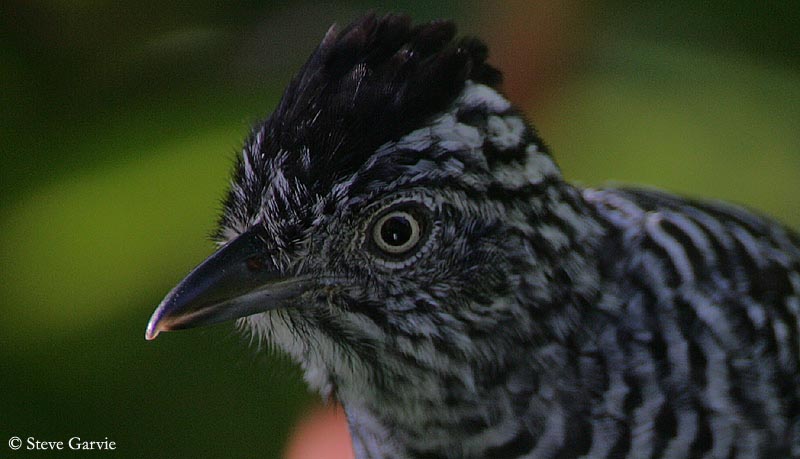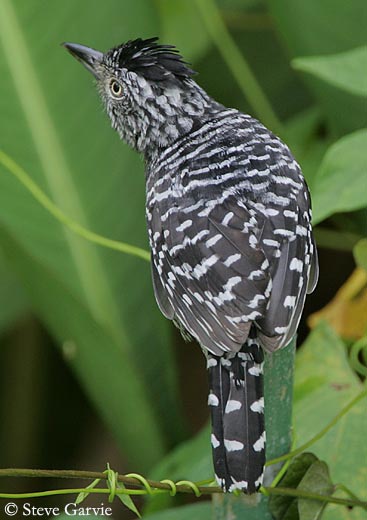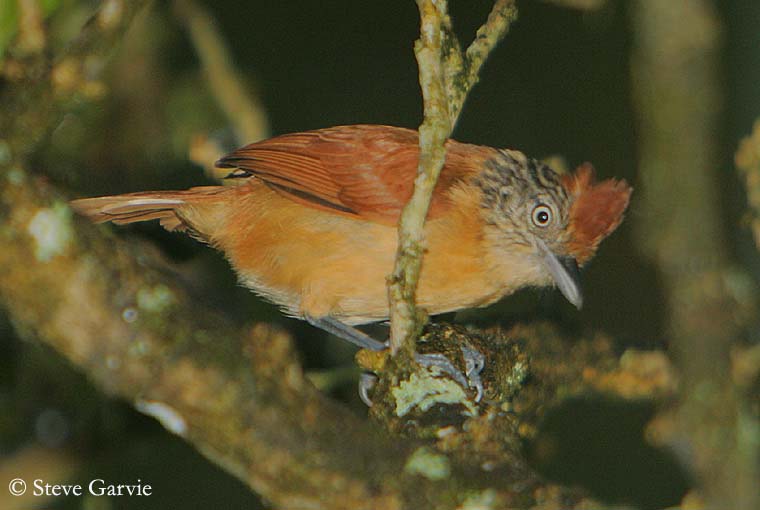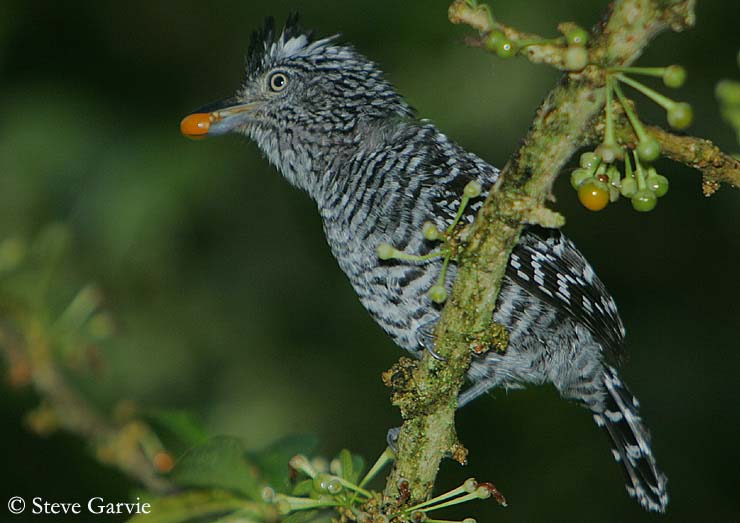
Barred Antshrike
Thamnophilus doliatus
Passeriforme Order – Thamnophilidae Family
BIOMETRICS:
Length: 14-17 cm
Weight: 25-30 g
DESCRIPTION:
Barred Antshrike is very common and familiar.

Adult male has barred black and white plumage overall, including wings and tail.
On the head, plumage is striped black and white, and we can see a crest with white base and black tips. Straight bill is blackish, with bluish-grey lower mandible. Eyes are yellow. Legs and feet are blue-grey.
Adult female has chestnut-brown upperparts, wings and tail. Underparts are buff-brown, becoming paler on breast, throat and chin. On the head, crown and erectile crest are rufous. Face, ear coverts and nape are striped buffy-white and blackish. Bill, eyes, legs and feet are as in male.
Immature male has flanks and belly washed buff.
Immature female has dusky bars and spots on breast.
Juvenile male resembles adult, but barred dark brown and buff.
Juvenile female is similar to adult, but head and upperparts are barred blackish, and underparts are scaled dusky.

VOICE:
Barred Antshrike pair utters wide variety of songs and calls as contact sounds, such as crow-like cawing “arrrr”, a slow “hoo-hoo”, and series of 6 to 8 nasal “kyow”, rising and falling.
Song is an accelerating series of numerous “cah” or “cow”, ending with strong, nasal “graaaaa”.
When Barred Antshrike utters its song, it stretches the neck, erects its crest, and produces vibrations on its semi-fanned tail by wagging it rapidly.
HABITAT:
Barred Antshrike is common in semi-open areas such as dry forests and wooded savannahs, humid to semi-arid second growth, forest edges and thickets. Rarely seen in dense forest, it may be found from 100 to 2,000 metres of elevation.
RANGE:
Barred Antshrike is resident from southern Mexico to northern Argentina east of the Andes Mountains.
It is widespread in Brazil, but confined to the bushy edges of rivers and islands.
BEHAVIOUR:
Barred Antshrike usually feeds in mixed flocks, between low bushes and treetops. It gleans in foliage for invertebrates, catching high diversity of arthropods. They occasionally may follow army ants.
They are usually seen in pairs, at about one to six metres high, well concealed in foliage. Both mates call frequently as they move around.
Male in alert erects its crest.
FLIGHT:
Barred Antshrike generally performs short flights.

REPRODUCTION:
Barred Antshrike breeds in shrubs and thickets. Nest is loose open cup made with grasses, vines and rootlets, suspended from low fork, under thin branch, or in low bush.
Female lays 2 white eggs, with dark brown or grey spots. Incubation lasts about 14 days, by both parents.
Altricial chicks are fed by adults, and leave the nest about 12 to 13 days after hatching.
This species produces two broods per season.

DIET:
Barred Antshrike is insectivorous, feeding on ants, wasps, termites, beetles and spiders. It also may consume small lizards and berries. It usually hunts through low bushes.
PROTECTION / THREATS / STATUS:
Barred Antshrike is very common and widespread in its range.
Fr: Batara rayé
All : Bindenameisenwürger
Esp : Batará Barrado
Ital : Averla formichiera barrata
Nd : Gebandeerde Mierklauwier
Russe : Полосатая сорокопутовая муравьеловка
Photographs by Steve Garvie
His website : RAINBIRDER Photo galleries
Text by Nicole Bouglouan
Sources :
HANDBOOK OF THE BIRDS OF THE WORLD Vol 8 by Josep del Hoyo-Andrew Elliott-David Christie - Lynx Edicions - ISBN: 8487334504
A GUIDE TO THE BIRDS OF COLOMBIA by Steven L. Hilty and William L. Brown
Princeton University Press – ISBN 069108372X
Wikipedia (Wikipedia, The Free Encyclopedia)